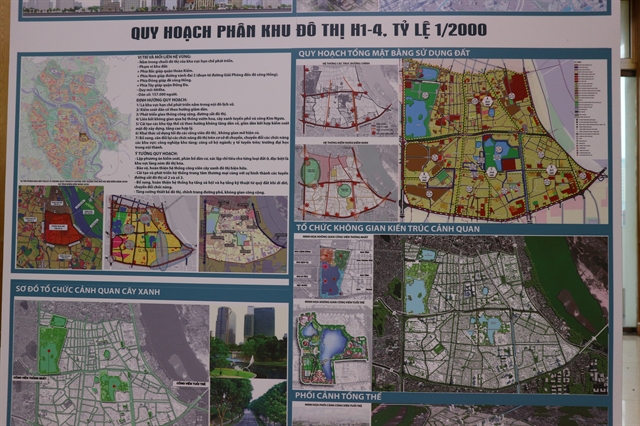 Society
Society

More than 215,000 people living in four inner districts of Hà Nội will be relocated under an urban planning project which aims to decrease population density and upgrade infrastructure.

|
| Maps with detail urban planning of four inner districts in Hà Nội are made public on Monday. — VNA/VNS Photo |
HÀ NỘI — More than 215,000 people living in four inner districts of Hà Nội will be relocated under an urban planning project which aims to decrease population density and upgrade infrastructure.
The city’s authorities on Monday morning made public maps detailing six urban planning zones in Hoàn Kiếm, Ba Đình, Đống Đa, Hai Bà Trưng districts designed by the municipal Department of Planning and Architecture, covering an area of more than 2,700ha.
The plan targets to reduce the population in the four districts from the current 887,000 to 672,000 by 2030.
The city’s authorities plan to relocate residents from now until 2030 for land clearance and road expansion, at the same time, relocate industrial parks, hospitals and headquarters of ministries and agencies out of the four districts to have space for public infrastructure and green space.
According to the maps, Hoàn Kiếm Lake and neighbouring areas have been identified as the capital’s famous scenic area and will act as a cultural, administrative, commercial, service, tourism centre combined with housing and community buildings for historical, cultural, religious activities.
The old streets will be the location of historical, cultural, religious relics, villas, houses, offices, commercial, financial, cultural, medical services and other community works.
Houses in the Old Quarter must not be built higher than four floors or 16 metres high.
The urban planning project also looks to develop urban railways in the four inner districts, networks of urban areas north of Hồng (Red) River, the east of Ring Road No 4 and satellite urban areas.
After infrastructure construction has been completed in those areas, it will attract the relocation of residents out of the centre.
Lưu Quang Huy, head of the city’s Construction Planning Institute, said roads designed on the maps would be connected together, along with ring roads, to create a network linked with the city centre.
High-rise buildings will be built along the ring roads, city centre-connected routes and urban residential quarters, Huy told the Government portal.
The city plans to build underground walking lanes connected with underground public transport and underground stations.
Dương Đức Tuấn, vice chairman of the city People’s Committee, said the urban planning of four inner districts was very important. The city’s authorities have asked the authorities of four districts to supervise the planning progress and identify construction violations.
The urban planning of Hà Nội’s four inner districts and the planning of Hồng and Đuống rivers to be published will improve the city’s infrastructure and local livelihoods towards modernisation and civilisation, he said.
The plan to ease the Old Quarter’s population density began in 1998 when the Hà Nội People's Committee said it hoped to decrease the population density from 823 people per hectare in 2010 to 500 in 2020, improve living conditions and preserve heritage sites in the Old Quarter.
Figures released in 2016 from the Old Quarter Management Board showed 800-1,200 people lived in the area per hectare.
Covering a total of 81 hectares, the Old Quarter includes 36 streets, stretching from Hoàn Kiếm Lake to the south, Long Biên Bridge to the north, Trần Nhật Duật Street to the east and the citadel wall on Lý Nam Đế Street to the west.
The streets have developed with shops at the front and living areas in the back. As a result, homes have become increasingly narrow and streets increasingly busy.
According to the plan, up to 6,500 households with 27,000 people in Hoàn Kiếm District were to be relocated.
One proposed resettlement area covers more than 11ha in Việt Hưng New Urban Area in Long Biên District and includes 16 buildings with eight to nine stories each and public works like kindergartens, schools and health clinics.
However, the plan has so far been delayed due to a number of hindrances. — VNS




